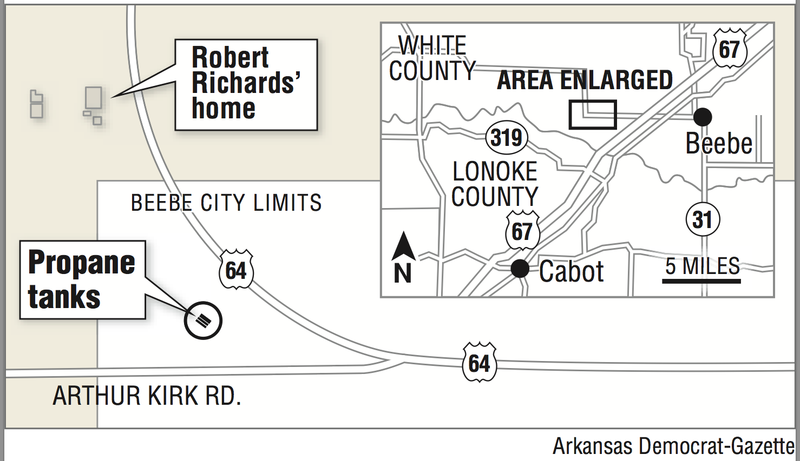CORRECTION: An Arkansas Highway and Transportation Department contract to widen a 3.37-mile section of U.S. 64 in 2016 begins west from Beebe and another 3-mile section of the highway also scheduled to be awarded a contract begins at Turner Road. This article misstated the location of the projects.
State agencies say three propane storage tanks on a big curve on U.S. 64 just inside the city limits of Beebe are far enough from the busy highway to pose no danger, even after the road eventually is widened from two lanes to five lanes.
But they don't live next door to the propane tanks like Robert Richards does.
The retired schoolteacher said he worries that an errant log truck or other vehicle will fly off the curve, hurtle down the hill and crash into the tanks, which hold about 30,000 gallons of the liquid fuel, in a fiery explosion.
He has tried without success to have the tanks removed since they were installed five years ago, lodging complaints with state and federal elected officials on down.
"I did everything I could do," Richards said.
But agencies that include the Arkansas Liquefied Petroleum Gas Board and the Arkansas Highway and Transportation Department, which hold regulatory powers, have repeatedly looked into his concerns and have dismissed them.
Richards is especially concerned about the logging trucks that ply the route daily.
"You only need one incident to have a disaster," Richards said. "I don't think [the tanks] could withstand a load of logs."
The owner of the tanks, Robert Reeves, called Richards' complaints overblown, noting that over the years, his complaints have reached all the way to U.S. Department of Homeland Security.
Reeves, who began his Batesville-based company 22 years ago, said he located the tanks on the west side of Beebe to serve as a facility to service residential and commercial customers in the area. He said he conducted his due diligence to ensure he wouldn't pay "a penny for a property that I couldn't use."
The tanks are 160 feet from the highway, are 6 feet off the ground and are protected by concrete crash barriers, he said.
"There's no danger to no one," Reeves said.
Janice Coates agrees. She is the longtime director of the state Liquefied Petroleum Gas Board, which is tasked with regulating the propane industry.
She can only recall one storage tank explosion in her 41 years at the agency, an incident that occurred in the 1970s.
Other propane containers have been involved in explosions over the years. The Arkansas Department of Emergency Management has counted four incidents since 2010 involving propane tanks.
The latest occurred at a house in Marion County earlier this year in which an explosion and fire a propane tank, but the incident was labeled as suspicious, according to Krista Guthrie, the agency spokesman.
The others included a 2013 incident in Yell County in which a propane tank leaked and caught fire at a business, a 2012 incident in White County in which six propane tanks exploded at a business as a result of a fire, and a 2010 incident in Little River County in which a structure fire at a business caused a propane tank to explode.
Coates' agency has regulations requiring tanks of the size Reeves has on the property to be a minimum of 50 feet from a roadway and 50 feet from a property line.
"He's a very good, conscientious dealer," Coates said of Reeves. "He's trying to do things right."
The Arkansas Transportation Highway and Transportation Department found the tanks to be well within the national highway design standards it must follow.
It and other state transportation agencies follow design standards developed by the American Association of State Highway and Transportation Officials. Its 2011 Roadside Design Guide requires 30 feet of a "minimum recommended clear distance from the edge of the traveled way for a design speed of 60 mph with [an average daily traffic] of greater than 6,000 vehicles," according to Danny Straessle, a department spokesman.
The area must be "unobstructed and traversable for use in the recovery of errant vehicles per AASHTO recommendations," he said in an email, referring to the association.
Even after U.S. 64 is widened, "the distance between the tanks [and] the lane line of the proposed improvements will be approximately 150 [feet], which is 120 [feet] beyond the minimum recommendation," Straessle said.
The department is scheduled to award a contract to widen a 3.37-mile section of U.S. 64 west from Batesville that includes the curve, likely in the summer of 2016, Straessle said.
It is part of a larger initiative to widen U.S. 64 to four and five lanes between Beebe and Vilonia.
A project to widen a 7.43-mile section east from Vilonia is scheduled to be awarded a contract in October, though given the uncertainties of federal funding, it could be delayed as other projects have been this year, Straessle said.
A 3-mile section from Tanner Road to White County Road 5 is scheduled to be awarded a contract early next year. It is part of the Connecting Arkansas Program, a $1.8 billion construction program financed in part by a temporary 0.5 percent increase in the state sales tax that is in place for 10 years.
Richards, 65, has lived on the property, which totals about 120 acres, all of his life. He said he expects he will have to build a new house farther back on the property because the department's new right-of-way when U.S. 64 is widened will be 6 feet from his front door. The new location of the house remains too close to the tanks, he said.
He has retained a lawyer to address the price the department wants for the property it needs for the project. The amount, about $34,000, for a half-acre isn't enough, Richards said.
Metro on 08/17/2015
